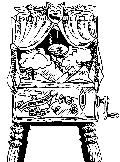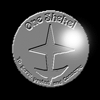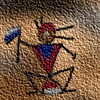


 |  |  |
|---|
| ||
|---|---|---|
 A mechanical device, typically coin-operated, which make a little mechanical "play", in order to animate some sort of story. The length of these "plays" varies greatly, but they typically only last a few seconds or -- at the most -- minutes long. A few variations allow some sort of interaction from the viewer, making them games of a sort. A mechanical device, typically coin-operated, which make a little mechanical "play", in order to animate some sort of story. The length of these "plays" varies greatly, but they typically only last a few seconds or -- at the most -- minutes long. A few variations allow some sort of interaction from the viewer, making them games of a sort.Most Shekelodeons are of Chronotopian design, but there have been rumors of Titanian versions of Shekelodeons, which are more akin to games of chance ... purportedly with dire consequences for anyone who has the misfortune of losing. | ||
| ||
 The Shekel is the standard unit of currency in Rephidim, and, since it is the dominant power to deal with, in Sinai at large. The Shekel is the standard unit of currency in Rephidim, and, since it is the dominant power to deal with, in Sinai at large. When one refers to a "shekel" alone, it typically refers to the basic unit, a ceramic coin which is worth a cup of grain -- or roughly $1 for comparison. Greater denominations are represented by copper, iron, silver, and ultimately gold -- progressively rarer minerals on Sinai. 1 gold = 5000 shekels; 1 silver = 1000 shekels; 1 iron = 500 shekels; 1 copper = 100 shekels. The typical inn costs 5 shekels per night, not including food, and meals run between 3 and 5 shekels. There are half- and quarter-shekel pieces. | ||
| ||
| ||
| Red moon of the planet Abaddon. Although devoid of any native plant life, Sheol has been reported to have a breathable atmosphere, another product of Sifran terraforming, since the planet is not large enough to sustain a gravity sufficient to keep an atmosphere of its own. Sheol is home to a moon base supported by the Abaddonians, fortified in recent years in an attempt to defend against an attack that was believed to be destined to come from the Silent Ones under the leadership of a heretical leader known as "Light-of-Star". Sheol is also the name of a lesser deity of the Olympian Pantheon, associated with death and ashes. | ||
| ||
 "Shiga" refers to actually quite a number of reptilian races found in the Savan, within the boundaries of the Nagai Empire. The only common factor between these races is that they possess four limbs (which may be any combination of legs, arms or wings), are reptilian, and are sapient. Most commonly, they are humanoid in form. "Shiga" refers to actually quite a number of reptilian races found in the Savan, within the boundaries of the Nagai Empire. The only common factor between these races is that they possess four limbs (which may be any combination of legs, arms or wings), are reptilian, and are sapient. Most commonly, they are humanoid in form.The plural for "Shiga" is either "Shigas", or else "Shigai" (typically used when referring to the "race" as a group). Though not "proper", the use of the word "Shigai" when referring to a SINGLE Shiga is in such widespread use (at least among those who even know of the Shigai) that it is, in essence, interchangeable. (The same is the case for Chiga/Chigai, Rokuga/Rokugai, and Kiriga/Kirigai ... but woe to anyone who calls a single Naga a "Nagai"!) | ||
| ||
| | ||
| ||
 Also known as a "sand-shark", this creature is only known to be found in the Sea of Sand in the Himaat, and is believed to be a nasty "cousin" of the less-feared Gooshurm. Shrikens have some slight resemblance to Gooshurms, appearing to be large, segmented, worm-like or serpentine creatures, but their segments appear to be bony, each segment having three bony fins that radiate outward. The head consists of three bony jaws, with no visible eyes, and the mouth contains three flexible tongues which are barbed and secrete a paralyzing toxin. Also known as a "sand-shark", this creature is only known to be found in the Sea of Sand in the Himaat, and is believed to be a nasty "cousin" of the less-feared Gooshurm. Shrikens have some slight resemblance to Gooshurms, appearing to be large, segmented, worm-like or serpentine creatures, but their segments appear to be bony, each segment having three bony fins that radiate outward. The head consists of three bony jaws, with no visible eyes, and the mouth contains three flexible tongues which are barbed and secrete a paralyzing toxin. Shrikens rarely live to grow to full adult size, typically found at no greater than a few feet in length, but there are legends of gigantic shrikens capable of smashing sand-triremes or swallowing victims whole. Some credence is lent to these legends in that the sand-faring Nohbakim often use very large bony structures for the supports for their sand-triremes ...which would tend to suggest the existence of suitably large creatures to provide the skeletons from which these structures are made! | ||
| ||
 The theology of the Hekoye centers around their god, Shung Matu, who is seen as less than benevolent, more of a prankster god who seems to delight in bringing misery to his creations. However, the Hekoye accept all of this with reservation of passion, as their lot in life. Even those who master the magical arts of Sinai, they believe, are not spared from the trickery of Shung Matu. The theology of the Hekoye centers around their god, Shung Matu, who is seen as less than benevolent, more of a prankster god who seems to delight in bringing misery to his creations. However, the Hekoye accept all of this with reservation of passion, as their lot in life. Even those who master the magical arts of Sinai, they believe, are not spared from the trickery of Shung Matu.
| ||
| ||
| A type of tree found in the Himar Territories, used for lumber. | ||
| [Not common knowledge] There are legends that speak of the Silent Ones -- ancient ancestors of the cheetah-like Savanites, who predate even legends of a great Savanite Empire in the distant history of Sinai. The Silent Ones supposedly had great cathedral-ships that ferried them across the stars, and ruled a celestial empire, before they came down to Sinai. Their culture was one that revered the Star as a deity ... but portrayed this entity in a more warlike aspect. | ||
| ||
  Sinai is the fourth planet from the sun in the Primus System, and is close to being Earth-like in its variation of climates and its ability to sustain life. Sinai is slightly larger than Earth, for comparative purposes, but also somewhat lighter, due to a very low amount of heavy metals present. Sinai lacks a moon, though it is surrounded by a ring known to most Sinai-based cultures as the Procession ... and some theories hold that it may well be the remnant of a moon that was destroyed long ago by unknown forces. Sinai is the fourth planet from the sun in the Primus System, and is close to being Earth-like in its variation of climates and its ability to sustain life. Sinai is slightly larger than Earth, for comparative purposes, but also somewhat lighter, due to a very low amount of heavy metals present. Sinai lacks a moon, though it is surrounded by a ring known to most Sinai-based cultures as the Procession ... and some theories hold that it may well be the remnant of a moon that was destroyed long ago by unknown forces. Among so many other odd features, Sinai is characterized by floating "sky island" structures, the largest of which is capable of sustaining Sinai's most powerful city, Rephidim. Magic is known and practiced on Sinai, and it is known that magical powers (and a phenomenon known as "quantum uncertainty) are stronger near the surface, but weaker up at the level of sky islands. They are sometimes even more powerful in certain regions, such as a Forbidden Zone. At the same time, where magic is more powerful, machinery -- especially more complex mechanisms -- tends to be less reliable. A wide variety of creatures can be found on Sinai, including many sapient races so varied as to defy organized classification -- particularly due to the high incidence of mutation on the surface, and the occasional arrival of Exile races from other worlds. Most of the surface is covered by oceans, but there are three major land mass groups: Ai, Ur and Lamu. The sky islands drift freely across the globe, following varying courses, most not bound to any particular continent or other geographical anchor. | ||
| ||
| Loosely defined steppeland region located at the southwestern part of the Wandering Roams, located to the east of Bosch, and the north (and east) of Olympia. The only settlement here of note is the small "city" of Tsun-Lao, which houses a cluster of houses and marketplaces with which the wandering Sinha people do trade with the Olympians to the south. | ||
| ||
| The Sinha are a felinoid sapient species, characterized by having extremely long body fur, and colored markings that are similar to Siamese cats. As a culture, the Sinha are a nomadic people, wandering across a steppeland portion of the Wandering Roams known as the Sinh Range. They typically live in tents and temporary huts, roaming the steppes in the summer months, and coming together in larger, more stationary groups during the harsh winters. Sinha often work beads into long strands of their body fur, and sometimes trade with the Vykarin for bits of shell. | ||
| ||
| (not common knowledge outside of Ashtoreth) Sirens are a sub-type of Mariner (mer-cat) found on the water-world of Ashtoreth. They are distinctive in that they have large external translucent membranes that some describe as "wings", which serve as gills, making them amphibious, whereas Abyssianian Mariners merely have considerable lung capacity. It is a common myth that Sirens are all female, but each clan of Sirens is ruled by a male of their species, a Triton. Relations between the Sirens and other species are most often violent, thus little is known about them or their culture. | ||
| ||
 Found in the Ashdodite wilderness, these horseshoe-crab-like creatures can be found in greatly varying sizes, for they never stop growing. Their chitinous shells are very hard and covered with sharp, durable spines, and they have segmented, barbed, whip-like tails that are capable of lashing at enemies or even to propel the creature through the air, arcing like a cannonball shot. Found in the Ashdodite wilderness, these horseshoe-crab-like creatures can be found in greatly varying sizes, for they never stop growing. Their chitinous shells are very hard and covered with sharp, durable spines, and they have segmented, barbed, whip-like tails that are capable of lashing at enemies or even to propel the creature through the air, arcing like a cannonball shot.Skedats move about on multiple tiny little legs, and they have larger claws useful for handling prey and for flipping themselves back over if they are upended. They are very disagreeable, capable of making loud screeches that sound like fingernails scraping on slate, only amplified ... and they will charge "intruders" on their "territory". Skedat nests are noteworthy for the silvery sheen of the melon-sized eggs. At first glance, they may be mistaken for metal, because of the high silicon content. "Skedat" is also the name used for a weapon favored by the warriors of Ashdod, fashioned from a skedat shell, hollowed out to cover the hand and part of the forearm, held with a supporting grip. Thus, it serves as a shield and a weapon, what with the sharp spikes. Sometimes the segmented tail is left on, used by more experienced warriors as a barbed whip. "Skedat armor" is made from shells of varying sizes, and it is common for warrior cults of Ashdod to send out young warriors to prove themselves by defeating a skedat in unarmed combat, then to fashion a weapon from the shell. |
| Home Page |
Player Guide |
Log Library |
Recent Logs |
|---|---|---|---|
| Encyclopedia |
Dramatis Personae |
Art Gallery |
Moz Ezley Asylum |